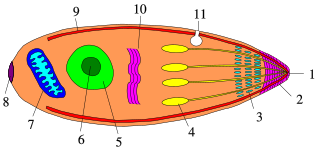
Plasmodium is a genus of unicellular eukaryotes that are obligate parasites of vertebrates and insects. The life cycles of Plasmodium species involve development in a blood-feeding insect host which then injects parasites into a vertebrate host during a blood meal. Parasites grow within a vertebrate body tissue before entering the bloodstream to infect red blood cells. The ensuing destruction of host red blood cells can result in malaria. During this infection, some parasites are picked up by a blood-feeding insect, continuing the life cycle.
Giovanolaia is a subgenus of the genus Plasmodium created by Corradetti et al. in 1963. The parasites within this subgenus infect birds.
Plasmodium brumpti is a parasite of the genus Plasmodium subgenus Sauramoeba. As in all Plasmodium species, P. brumpti has both vertebrate and insect hosts. The vertebrate hosts for this parasite are reptiles.
Plasmodium chiricahuae is a parasite of the genus Plasmodium subgenus Paraplasmodium.
Plasmodium cnemidophori is a parasite of the genus Plasmodium subgenus Sauramoeba. As in all Plasmodium species, P. cnemidophori has both vertebrate and insect hosts. The vertebrate hosts for this parasite are lizards.
Plasmodium diploglossi is a parasite of the genus Plasmodium subgenus Sauramoeba. As in all Plasmodium species, P. diploglossi has both vertebrate and insect hosts. The vertebrate hosts for this parasite are reptiles.
Plasmodium eylesi is a parasite of the genus Plasmodium subgenus Plasmodium.
Sauramoeba is a subgenus of the genus Plasmodium, all of which are parasitic eukaryotes. The subgenus was created in 1966 by Garnham. Species in this subgenus infect reptiles.
Carinamoeba is a subgenus of the genus Plasmodium - all of which are parasitic unicellular eukaryotes.
Plasmodium rhadinurum is a parasite of the genus Plasmodium subgenus Carinamoeba.
Plasmodium diminutivum is a parasite of the genus Plasmodium subgenus Carinamoeba.
Plasmodium uluguruense is a parasite of the genus Plasmodium subgenus Lacertamoeba.
Plasmodium loveridgei is a parasite of the genus Plasmodium subgenus Lacertamoeba.
Plasmodium juxtanucleare is a species of parasite in the family Plasmodiidae. The vertebrate hosts for this parasite are birds.
Plasmodium fieldi is a parasite of the genus Plasmodium sub genus Plasmodium found in Malaysia. This species is related to Plasmodium ovale and Plasmodium simiovale. As in all Plasmodium species, P. fieldi has both vertebrate and insect hosts. The vertebrate hosts for this parasite are primates.
Plasmodium vaughani is a parasite of the genus Plasmodium, and the type species of the subgenus Novyella. As in all Plasmodium species, P. vaughani has both vertebrate and insect hosts. The vertebrate hosts for this parasite are birds.

Apicomplexans, a group of intracellular parasites, have life cycle stages that allow them to survive the wide variety of environments they are exposed to during their complex life cycle. Each stage in the life cycle of an apicomplexan organism is typified by a cellular variety with a distinct morphology and biochemistry.
Plasmodium alaudae is a parasite of the genus Plasmodium.
Plasmodium mabuiae is a parasite of the genus Plasmodium subgenus Carinamoeba.

